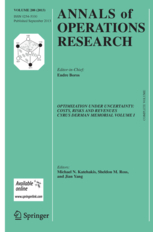This paper was written in 2010 and appeared on-line in 2011. It has taken Annals of Operations Research more than 3 years to publish the paper. This paper combines a deterministic contextual variables model with a Malmquist productivity analysis. The methods are applied to Ohio school data. See the abstract below for more details.
This paper was written with John Ruggiero one of the most widely cited researchers in the area of DEA. John and I have written several papers over the years and he has acted as a mention to me. He is generally considered to be the life of the conference as most academic conferences he attends.
Abstract
Nondiscretionary environmental inputs are critical in explaining relative efficiency differences and productivity changes in public sector applications. For example, the literature on education production shows that school districts perform better when student poverty is lower. In this paper, we extend the nonparametric approach to decompose the Malmquist Productivity Index suggested by Färe et al. (American Economic Rewiew 84:66–83, 1994) into efficiency, technological and environmental changes. The approach is applied to analyze educational production of Ohio school districts. Applying the extended approach in an analysis of the educational production of 604 school districts in Ohio, we find changes in environmental harshness are the primary drivers in productivity changes of underperforming school districts, while technical progress drives the performance of top performing school districts.

